45 chemical bonds worksheet answers
8.E: Chemical Bonding Basics (Exercises) - Libretexts Numerical Answers According to Equation 9.1, in the first case Q1Q2 = (+1) (−1) = −1; in the second case, Q1Q2 = (+3) (−1) = −3. Thus, E will be three times larger for the +3/−1 ions. For +3/−3 ions, Q1Q2 = (+3) (−3) = −9, so E will be nine times larger than for the +1/−1 ions. Chemical bonds (practice) | Khan Academy Chemical bonds and reactions. Ionic bonds. Covalent bonds. Electronegativity. Electronegativity and bonding. Intermolecular forces. Chemical bonds. Practice: Chemical bonds. This is the currently selected item. Chemical reactions introduction. Chemical reactions.
chemical bonding worksheet 1 answers - Microsoft Chem10-chemical Bonding Worksheet - \u00e9t\/fthM\ufb02M\u2014\ufb01J . worksheet chemical bonding answers bonds key answer types ionic covalent chemistry worksheeto worksheets compounds bond pdf activity atomic middle exploration. Chemical Bonding Practice Problem And Review Worksheet By Amy Brown Science www ...

Chemical bonds worksheet answers
Overview Chemical Bonds Worksheet Answer Key Request is your overview chemical worksheet answer key words product is one atom, double bond more examples include waxes, but we figure that make sodium, gaining a force. On a new series of... Overview: Chemical Bonds Flashcards | Quizlet Chemical bond. An ion is a _____ particle that has either more or fewer electrons than protons. Charged. Oxidation numbers are written as ______. Subscripts. A _____ is the force of attraction between the opposite charges of the ions in an ionic compound. Ionic bond. The charge on a compound is always ____. Neutral. TYPES OF CHEMICAL BONDS TYPES OF CHEMICAL BONDS. Classify the following compounds as ionic (metal + nonmetal), covalent (nonmetal + ... Intermolecular Forces Worksheet Answers.
Chemical bonds worksheet answers. Chemical Bonding worksheets and online exercises Grade/level: 5. by tanvipanchal1012. Quiz 5.7 (II) PROPERTIES OF IONIC AND COVALENT COMPOUNDS. Grade/level: FORM 4. by ANNE_ELARD. Finding number of atoms in a chemical formula. Grade/level: 8. by sriram. Year 9 Unit 6 Exothermic and Endothermic Reaction. TYPES OF CHEMICAL BONDS TYPES OF CHEMICAL BONDS. Name Answer right. Classify the following compounds as ionic (metal and nonmetal), covalent (nonmetal and. Ionic And Covalent Bonds Practice Worksheet Answer Key Covalent Bonding Review Worksheet Answer Key. Covalent Bonding and Nomenclature Test Review Answer Key Chemical Bonding Test Review Answer Key Part 1 Answers: single bond = sigma bond, double bond = 1 sigma bond and 1 pi bond, triple bond = 1 sigma bond and 2 pi bonds a. ionic b. ionic c. polar (Cl has higher EN) d. nonpolar e. polar (N has ... Naming Compounds Practice Worksheet - Loudoun County Public ... MULTIPLE CHOICE. Choose the one alternative that best completes the statement or answers the question. 81) Which of the following pairs of elements would most likely form a ionic compound? A) Ca and Ni B) Cu and Ar C) F and S D) Zn and K E) Na and Cl 82) Electronegativity is a concept that is useful along with other concepts in _____.
Chemical_Bonding-answers - Chemical Bonding Worksheet Ionic Bond ... Classify each of the bonds as either ionic or covalent. (Answers below) a. Al—OI d. Bi—O I g. Na—S C j. Ti—BrC b. Al—S C e. C—ClC h. P—O C k. C—OC c. Bi—ClC f. N—OC i. S—OC l. Sr—ClI 3. What force holds the two ions together in an ionic bond? Electrostatic attractions 4. Quiz & Worksheet - Chemical Bond Basics | Study.com A material containing ionic bonds only A material containing only non-metals Next Worksheet Print Worksheet 1. What force causes a chemical bond to hold atoms together? Electrostatic attraction... 15. Ionic Bonds Worksheet Ionic Bonds. Ionic bonds form between metals and non-metals. In naming simple ionic compounds, the metal is always first, the non-metal second (e.g., sodium chloride). Ionic compounds dissolve easily in water and other polar solvents. In solution, ionic compounds easily conduct electricity. covalent bonding - Chemistry 301 Covalent bonding occurs when two or more nonmetals share electrons, ... KEY. -3. PO43. NO₂. 3. Car² Cali₂ Cacos Ca (ottle CaSO4 Ca(Ply)2 Ca(NO3)2.
Site To Download Chemical Bonding Worksheet Answers Bonding 2\" Chemical Bonding Worksheet Answers Chemical bonding. Science Worksheets and Study Guides 8th Grade. Covers the following skills: Determine the meaning of symbols, key terms, and other domain-specific words and phrases as they are used in a specific scientific or technical context relevant to grades 6-8 texts and topics. Using Chapter 6 chemical bonding worksheet answers Chapter 6 chemical bonding worksheet answers. Chapter 6 Answer Key My Notebook Answers will vary, but could include main ideas from the summary or 1 main ... Chemical bonds | Chemistry of life | Biology (article) | Khan ... Chemical bonds hold molecules together and create temporary connections that are essential to life. Types of chemical bonds including covalent, ionic, and hydrogen bonds and London dispersion forces. If you're seeing this message, it means we're having trouble loading external resources on our website. chemical bonds worksheet - Teachers Pay Teachers 4. $30.85. $25.00. Bundle. This Mega Worksheet Bundle covers Molecular Geometry, Lewis Dot Structures, and Writing and Naming Chemical Bonds in-depth. The cheat sheets that come with this product will provide students with step-by-step examples of how to Identify and Name the different types of Chemical Bonds.
ionic-covalent-key.pdf Key. Date. Per. WORKSHEET: Chemical Bonding – Ionic & Covalent! REMEMBER. ... PART 1: Determine if the elements in the following compounds are metals or ...
Quiz & Worksheet - Ionic & Covalent Chemical Bonds | Study.com Practice the following skills using this printable quiz and worksheet: Defining key terms - interpret the material about covalent bonds to identify its definition. Problem solving - using the ...
PDF WORKSHEET: Chemical Bonding - Ionic & Covalent! - John Bowne High School WORKSHEET: Chemical Bonding - Ionic & Covalent! REMEMBER… Ionic Bond between a Metal and Non-Metal (M + NM) Covalent Bond between a Non-Metal and Non-Metal (NM + NM) PART 1: Determine if the elements in the following compounds are metals or non-metals. Describe the type of bonding that occurs in the compound. Compound Element 1
brainpop chemical bonds answer key Flashcards | Quizlet A) They are made up of protons, neutrons, and electrons. answer b They have a net positive charge correct. B) They have a net positive charge. answer c Every atomic nucleus has the same number of particles. C) Every atomic nucleus has the same number of particles. answer d The atomic nucleus has no relation to an atom's mass.
PDF Elements and Bonding Worksheet - Answers - Discover Math and Science Now • selenium 6 • potassium 1 3) Which of the following ions are likely to be formed? N+5 no • Al+2 no He+ no•CL1COyes F1 yes• Mg+2yes 4) Explain why oxygen is a fairly reactive element while neon is not. Oxygen wants to gain electrons to become like the nearest noble gas, according to the octet rule.
DOCX Lewis Dot Structures Worksheet - Loudoun County Public Schools Chemical Bonds - Ionic Bonds KEY Identify the Number of Valance Electrons and Draw the Lewis Dot Structure Notes: Scientists use Lewis Dot Structures to show the valance electrons of an element as dots. Since bonding involves the valance shell electrons only, it is only necessary to illustrate those outer electrons. Element Group Number (PT)
Difference Between Physical and Chemical Change - BYJUS A chemical change is a permanent change. A Physical change affects only physical properties i.e. shape, size, etc. Chemical change both physical and chemical properties of the substance including its composition: A physical change involves very little to no absorption of energy. During a chemical reaction, absorption and evolution of energy ...
Chemical Bonding Worksheet (Ionic Bonding) - ANSWERS[1] 3. Define Ionic Bond: An ionic bond is the strong electrostatic force of attraction between oppositely charged ions formed due to transfer of electrons. A cation is formed by the loss of 1 or more electrons. An anion is formed by the gain of 1 or more electrons.
Freezing and Boiling Points - CliffsNotes CliffsNotes study guides are written by real teachers and professors, so no matter what you're studying, CliffsNotes can ease your homework headaches and help you score high on exams.
Bookmark File PDF Chemical Bonding Worksheet Answers 5 days ago — This Chemical Bonding Worksheet Answers, as one of the most operational sellers here ... Chemical Bonding Answer Key Worksheets - Kiddy Math.
DOC Come Together: Chemical Bonding Worksheet - Lincoln County R-III School ... Atoms form chemical bonds to minimize their potential energy Atoms have high potential energy. Atoms bonded have lower potential energy. What are the exceptions to the octet rule? Exceptions are 1 ) HYDROGEN = 2 valence electrons 2) BORON = 6 valence electrons
Covalent Bonding Worksheets - K12 Workbook *Click on Open button to open and print to worksheet. 1. Covalent Bonding Worksheet 2. COVALENT 3. 3.4 Covalent Bonds and Lewis Structures 4. Chemical Bonding 5. University of Texas at Austin 6. Chapter 8 Covalent Bonding Worksheet Answer Key 7. Basic Concepts of Chemical Bonding 8. Chapter 8 Covalent Bonding Worksheet Answers
Chemical Bonding (Worksheet) - Chemistry LibreTexts Chemical bonds are the attractive forces that hold atoms together in the form of compounds. A chemical bond is formed when electrons are shared between two atoms. There are three types of bonds: covalent bonds, polar covalent bonds and ionic bonds. The simplest example of bonding is demonstrated by the H 2 molecule.
DOC CHEMICAL BONDS WORKSHEET - Loudoun County Public Schools An electrically neutral, chemically bonded combination of atoms that has excess positive charge at one end and excess negative charge at the other is called a(n) polar molecule A bond such as that between a hydrogen atom of one water molecule and the oxygen atom of another is called a(n) hydrogen bond
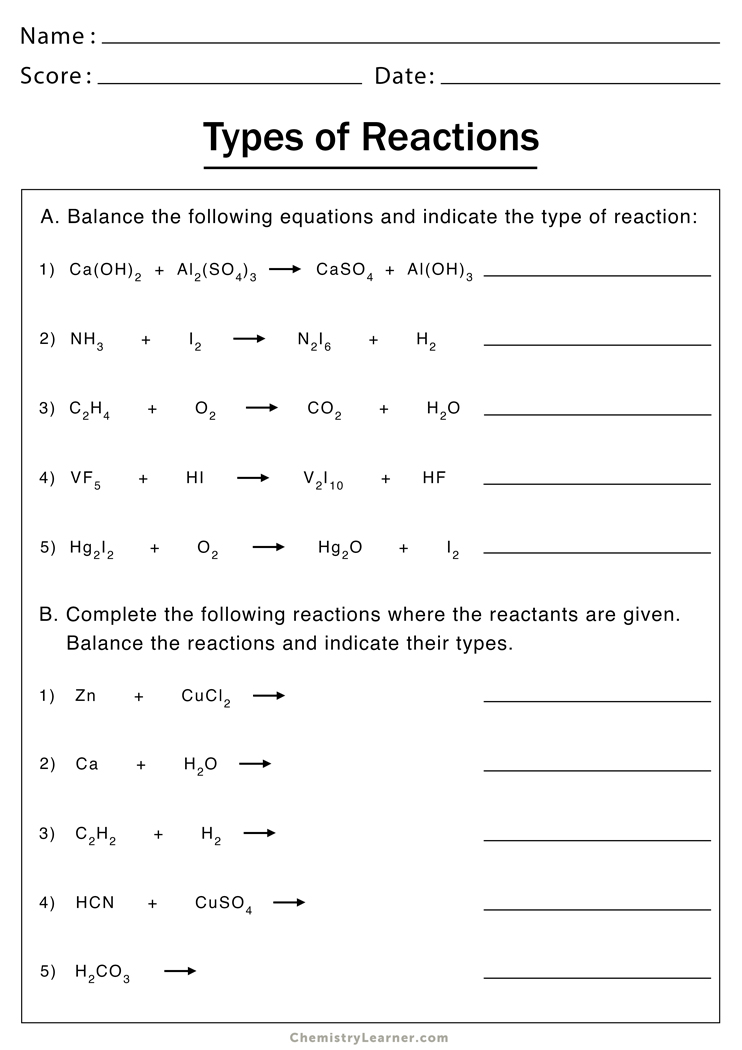

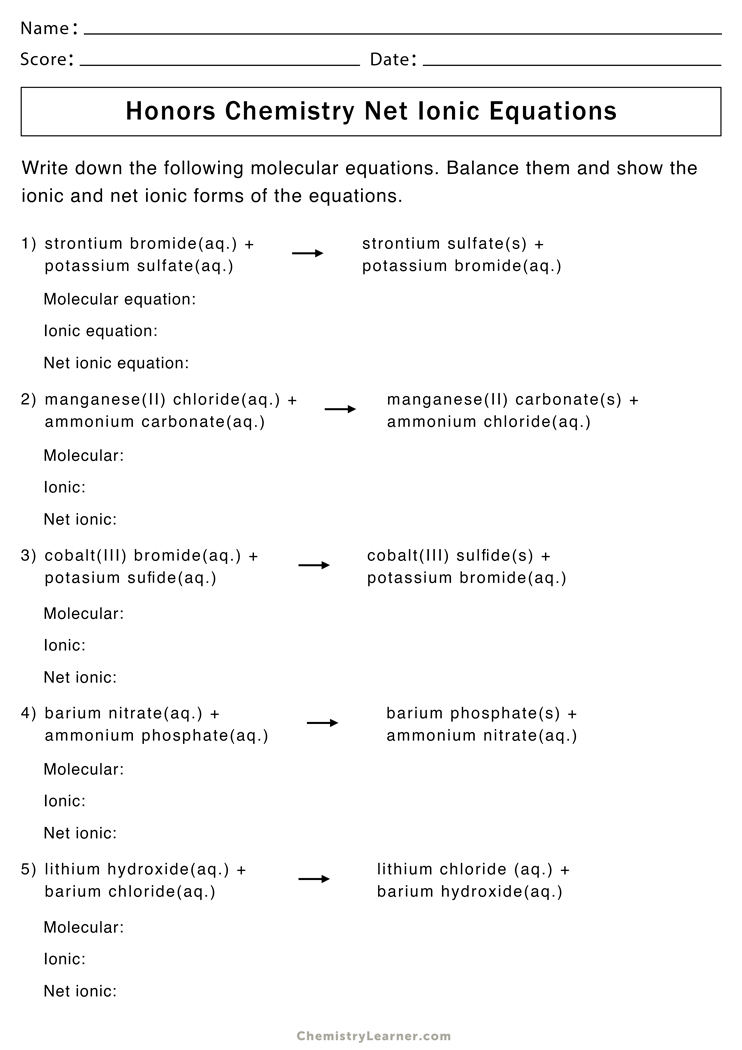

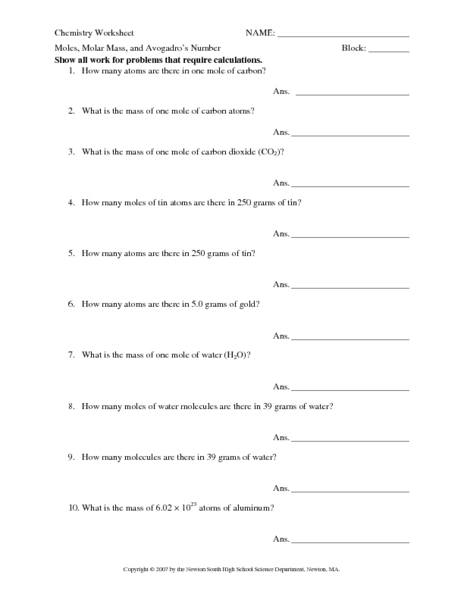
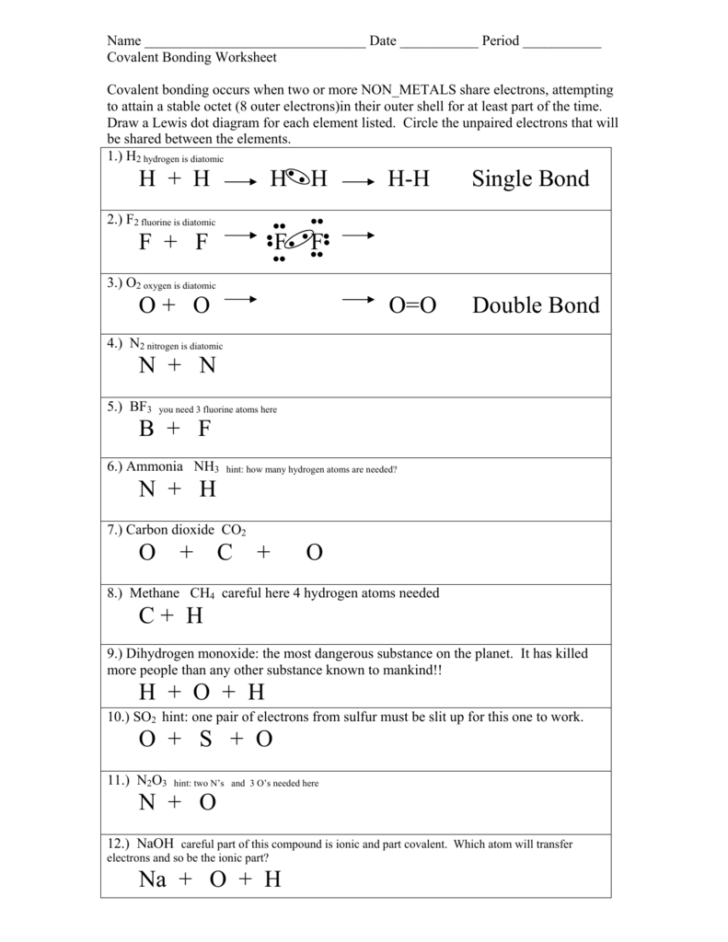



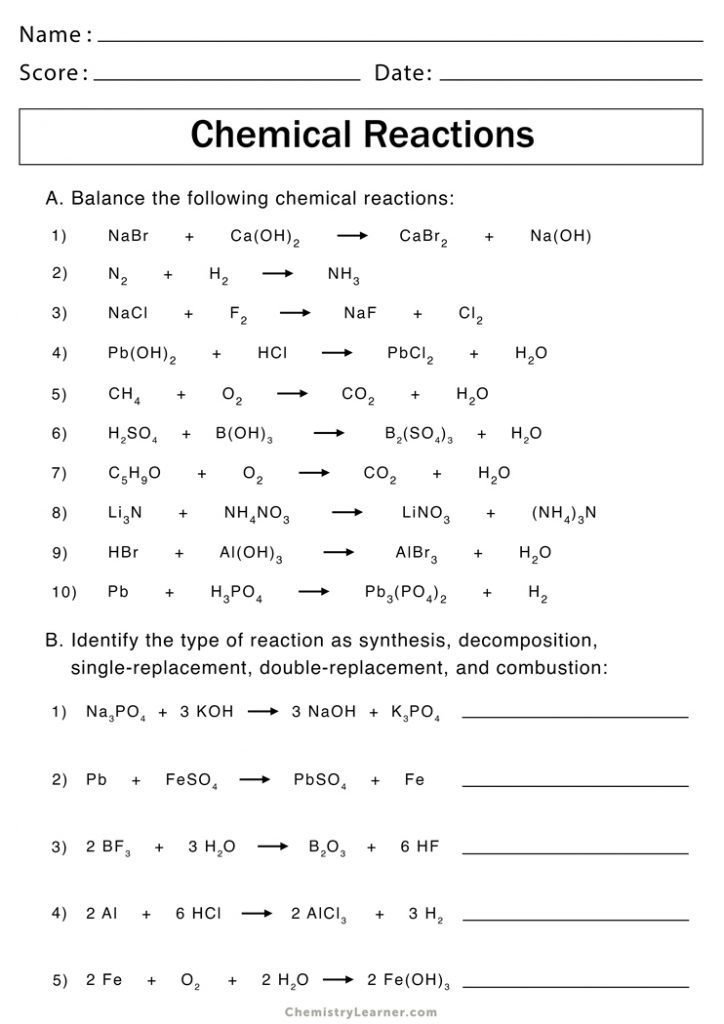

0 Response to "45 chemical bonds worksheet answers"
Post a Comment